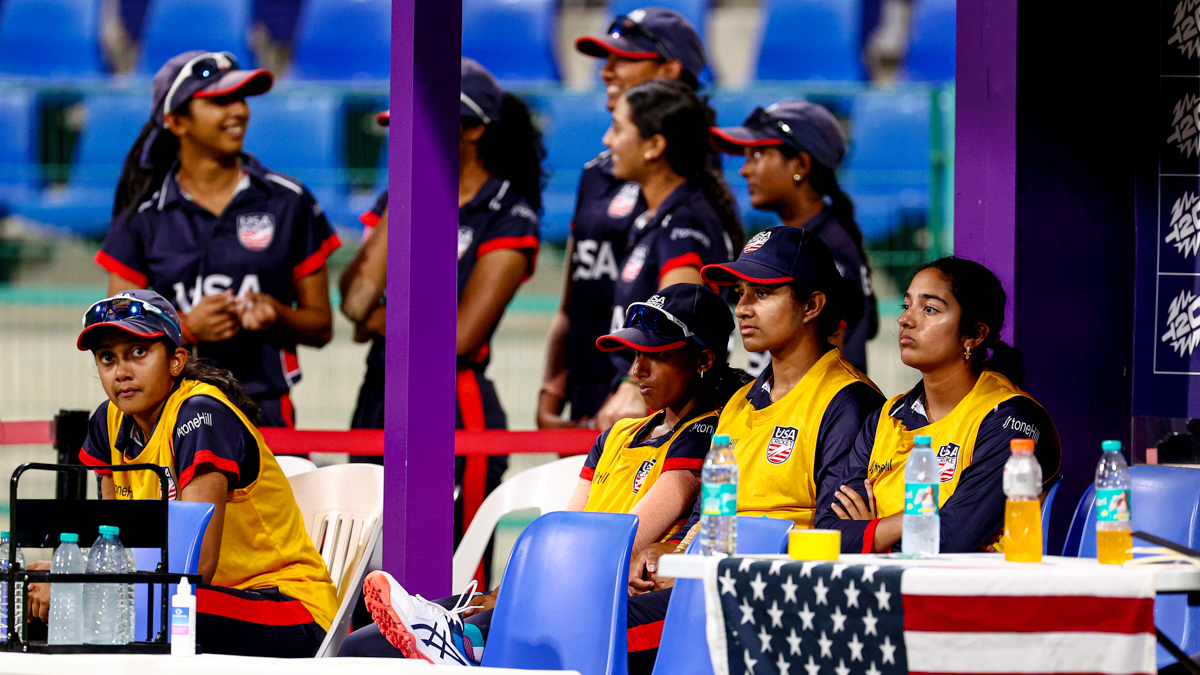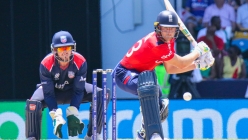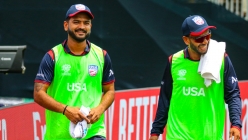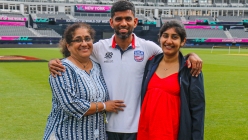Views
USA Cricket: 2024 ICC Women’s T20 World Cup Qualifier Tour Review Part 1 – Team Grades
2024 May 08 by DreamCricket USA

By Peter Della Penna (Twitter/X @PeterDellaPenna)Here's a through breakdown of the output of the USA Women's T20I squad at the 2024 ICC Women's T20 World Cup Qualfiier in the UAE, where USA returned without a win for the second time in a row.
Photo credit: Francois Nel/ICC/Getty Images
[Disclaimer - this review encapsulates USA's T20I section of their tour in Abu Dhabi of the UAE and not the two ODIs in Dubai to begin the tour.]
Batting: D
Compared to their last appearance at the ICC Women’s T20 World Cup Qualifier in the UAE in 2022, USA’s collective batting has shown improvement in some areas but also displayed regression in others.
USA finished the tour of the UAE with only one half-century across the entire team, which came in the opening warm-up match against UAE when Anika Kolan made an unbeaten 52 off 44 balls in a two-run loss. As for the four matches in the Qualifier itself, USA’s highest individual score was 30 off 26 balls made by Isani Vaghela in a situation where she rescued USA from embarrassment against Scotland, making those runs after entering at No. 8 when USA had been reduced to 50 for 7 in the 11th over chasing a target of 150.
USA’s highest scorer in the tournament was captain Sindhu Sriharsha, who made 63 runs in four innings with a best of 27 in the final match against Sri Lanka. Sriharsha ends as the team’s leading scorer for the second global qualifier in a row, but it is less than half of the 132 runs she produced at the same tournament in 2022.
In terms of partnerships, USA had a solitary half-century partnership during the entire tour, which came in the final match against Sri Lanka between Sriharsha and Disha Dhingra for the second wicket. When looking at both of those figures, one individual half-century on tour and one half-century partnership during the qualifier, those are not recipes for success.
Separately, USA’s power-hitting capabilities were non-existent. They struck one six on tour, off the bat of Isani Vaghela in a pre-tournament warm-up against Ireland. But as for the actual qualifier, USA ended as one of four teams (Zimbabwe, Vanuatu and Thailand) to not hit a single six in the entire tournament. By comparison, Scotland’s dynamic batting approach – which was wildly different from their failed qualification attempts of years past – put added emphasis on power-hitting and inventive strokeplay through things like scoops and reverse sweeps.
Unsurprisingly, Scotland’s massively improved batting is a major reason why they have qualified for their first ever Women’s T20 World Cup. Four separate players (Ailsa Lister, Darcey Carter, Megan McColl and Priyanaz Chatterji) hit sixes for Scotland, tied for most with Sri Lanka. Unsurprisingly, it is Sri Lanka and Scotland who have secured the two World Cup berths out of the qualifier. The fact that Lister and Carter came out of the same 2023 ICC Women’s U19 World Cup at South Africa that the majority of USA’s senior squad participated in shows that Scotland are doing some key things correctly from a skills and fitness development focus that USA is not.
Looking a bit deeper, the two sides who hit the most sixes outside of Scotland and Sri Lanka were UAE and Ireland, who both made the semi-finals. It’s pretty obvious to anyone watching the tournament that Thailand’s inability to hit sixes hampers their ability to set defendable targets. It trickles all the way down to USA. Even Uganda was able to clear the ropes against USA, with Immaculate Nakisuuyi’s straight six serving as a key moment in their successful chase.
In terms of USA’s shot development beyond that, there was marginal improvement in some areas. Pooja Ganesh showed a far greater willingness than most players to manipulate the crease. Kolan also showed flashes of both coming down the pitch to use her feet, shuffling across her stumps as well as playing late behind point to guide singles through the third region. Meanwhile captain Sriharsha continued her trademark soft hands against pace and spin picking out gaps behind square at will. But for the rest of the squad, there still remains a stubborn resistance to seek out scoring options outside the traditional V, in spite of not only what some of their teammates are showcasing successfully but more obviously what the opposition batting units accessed in their scoring zones and wagon wheels behind square.
Aside from the scoring zones, USA’s batters take the same guard at the crease 99% of the time. Very rarely, if ever, do batters do anything to disrupt the rhythm of the opposition bowler – whether it is walking across their stumps, backing away from leg stump, or coming down the wicket. Most of the time, USA’s batters let bowlers bowl to them however the bowler pleases and it continues a trend of not putting a bowler under any type of pressure.
Peculiarly, a delivery that USA seems to struggle with which other teams regularly attack is the full delivery on the stumps. USA’s batters have a default mechanism to defend anything on the stumps. They will attack a half-volley outside the stumps, but will defend a half-volley on the stumps. Looking at other teams, they will attack full deliveries regardless of whether they pitch in line with the stumps or outside. This was especially highlighted by Immaculate Nakisuuyi of Uganda, who pulverized anything full and straight. These are key scoring deliveries that USA misses out on.
Another glaring issue is the number of players who were bowled or lbw, especially when facing the moving ball against new ball swing bowlers or later on against stump to stump spinners. USA had 11 dismissals out bowled, three more lbw. The most shocking display came against Thailand. Basic, disciplined bowling attacking the stumps regularly resulted in six bowled and two lbw dismissals and exposed some terribly flawed techniques.
Another broadly tactical area where USA struggled is in the Powerplay as well as “impact overs” of 10 or more runs scored. USA’s average Powerplay score in the tournament was 26 for 2. Only once was their Powerplay score better than their opponent, when they made 33 for 1 against Uganda and Uganda started off 13 for 2 in six overs. But the eventual result in the Uganda match highlights a broader overarching issue that occurred across entire matches in terms of USA’s lack of impact overs vs the number of impact overs conceded. Starting with their two official warm-up matches against Zimbabwe and Ireland, USA scored one double-digit over each against Zimbabwe and Ireland. Zimbabwe’s batting unit produced six such overs while Ireland’s manufactured five of them – plus two nine-run overs – in a chase that only lasted two balls into the 16th over.
Once the tournament began, USA only produced six such impact overs (1 vs Uganda, 4 vs Scotland, 0 vs Thailand, 1 vs Sri Lanka). Meanwhile, USA’s opposition produced 16 such impact overs (4 by Uganda, 5 by Scotland, 0 by Thailand, 7 by Sri Lanka). These overs often produce major momentum swings. USA is largely incapable of shifting momentum on the batting side if they are not able to put bowling units under pressure through various means – lack of six-hitting, lack of rotation of strike, inability to find alternate scoring options when preferred/primary scoring option is blocked off.
The one silver lining is that USA has improved significantly in the department of running between the wickets. On this same tour in 2022, USA’s batting partners ran each other out at will. In this year’s tournament, they only had players runout four times.
All of these things add up. When looking at USA’s record in close matches (last-ball loss to UAE in the 2022 Women’s T20 World Cup Qualifier, last-over losses to UAE and Zimbabwe in pre-tournament warm-up matches in 2024, last-over loss to Scotland at Women’s U19 World Cup in 2023), these are the kinds of matches that teams who have a winning habit find a way to win while teams with a losing habit find a way to lose.
Bowling: C-
USA’s bowlers on the whole put in generally respectable performances given the circumstances they were presented with. Taking a warm-up match against Zimbabwe into the 19th over and restricting eventual tournament champion Sri Lanka to just 123 are commendable efforts. They also had next to nothing to work with in the match against Thailand when USA’s batters only gave them 54 runs to defend. Geetika Kodali led the team with four wickets, including some top-class names. On the whole, seven wickets were taken by pace bowlers and five by spinners though in many ways USA’s spinners were far more impressive especially in terms of economy rate.
USA’s fielding is incredibly weak, which exacerbates issues making bowlers figures look far worse than they actually should. USA’s fielders missed out on nine chances across four official tournament matches, not to mention countless misfields and misjudgments based on poor angles and routes taken to the ball. The missed chances resulted in USA bowlers only ending up with 12 wickets out of a possible 40 across four matches.
Having said that, USA’s number of impact overs conceded is alarming, and the situations they concede them in is also problematic. This is highlighted perfectly by the chase Uganda completed. USA’s bowlers had them restricted to 13 for 2 in the Powerplay, and then 41 for 2 after 11 overs chasing a target of 111. 70 needed off 9 overs is quite steep for Associate cricket standards, and yet Uganda made it there with 10 balls to spare because of a major momentum shift starting in the 12th over in which they scored 14 runs off back-to-back overs to turn the equation into a run-a-ball chase.
Another different but no less useful example is the Sri Lanka match. Sri Lanka produced seven impact overs totaling 77 runs. Three of those came in the final four overs of the innings when Sri Lanka went from 86 for 3 in 16 to 123 for 4. It means that USA held Sri Lanka to 46 for 3 off of 13 overs (3.53 run rate), and let them explode in the other seven overs (11 runs per over).
Such a disparity highlights the inconsistency in USA’s bowling. Similar in some ways to the batting side, USA can point to some moments of individual success, but they struggle to bowl in partnerships and can’t sustain pressure from both ends.
There was also a sharp contrast in pace vs spin. Five of the seven impact overs were conceded by pace against Sri Lanka. Three of the four against Uganda were conceded by pace and all five against Scotland were conceded by pace bowlers. It highlighted questionable selection tactics that began in squad selection before the start of the tour to pack the USA lineup with a pace heavy squad in conditions that historically favor slow bowling.
Partnership wise, USA conceded one century partnership to Uganda, one half-century partnership to Scotland and one half-century partnership to Thailand. Sri Lanka’s biggest partnership against USA was 49 runs. The only bowling units that were statistically worse than USA in terms of conceding huge partnerships were the Netherlands and Zimbabwe. Netherlands allowed unbroken partnerships of 104 in a 10-wicket loss to the UAE, as well as massive unbeaten 5th wicket stands against both Ireland (89) and Zimbabwe (85). Zimbabwe allowed the biggest partnership of the tournament against Ireland (130 runs) as well as stands of 71 against Netherlands and 52 against UAE.
Fielding: F
First-time commentators and observers of USA’s Women’s teams at different tournaments routinely comment that they are shocked at how poor they are in the field, with one tournament official at the 2023 U19 World Cup commenting that they could not understand how a country that produces a record number of female Olympic gold medalists across a variety of sports somehow has the most unathletic team in the tournament. Considering that there’s a significant overlap between the USA Women’s U19 and senior teams, a similar conclusion was drawn by several neutral watchers at this event in their first-time observations of USA.
USA missed nine chances in the field. Considering they were in the field for a total of 67.4 overs, that’s a missed chance every 7.5 overs, or roughly three every completed innings in the field. If you look at it compared to USA’s opponents, the superficial reaction would be that USA’s fielding is no worse than their opponents because USA’s opposition missed 10 chances in the field. The difference is that USA’s missed chances accounted for 41% of the actual chances generated by their bowlers and fielders (13 wickets taken, nine missed chances, so only 13 of 22 opportunities converted). Whereas USA’s opponents took 27 wickets, meaning they converted 73% of their chances in the field (27 out of 37) and were generating wicket-taking chances at a far more frequent rate than USA (22 chances across 67.4 overs for USA in the field, 1 chance created every 2.94 overs; 37 chances across 77.4 overs in the field by USA’s opponents, 1 chance created every 2.10 overs).
USA’s drops cost them a total of 115 runs after the first drop at an average of 38.33 runs per batter on missed chances (taking to account how many times the same batter was dropped and/or whether or not they finished not out). USA’s opponents missed chances cost them a total of 41 runs at an average of 5.86 (taking into account how many times the same batter was dropped and whether or not they finished not out). Again, this highlights the net run differential USA’s fielding cost them compared to the opposition. Effectively, USA’s fielding resulted in their opponents having a 33-run swing due to their good fielding vs. USA’s bad fielding. Nowhere is that more obvious than in USA’s 18-run loss to Sri Lanka. USA missed several straightforward chances in the field whereas Nilakshi de Silva took a pair of sensational catches sliding forward charging in from deep midwicket, the kinds of catches USA’s fielders were incapable of even getting a hand to let alone hold on to.
The only silver lining is that USA finally broke their runout drought at this tournament as Pooja Shah completed a runout from the midwicket boundary late in the innings against Sri Lanka to dismiss Nilakshi de Silva. It was USA’s first runout at the global qualifier in nine matches dating back to the loser’s bracket playoff win over Namibia at Scotland in 2019.
The most frustrating thing about USA’s fielding is that it is the easiest deficiency to rectify, yet continues to be a problem. Batting and bowling deficiencies are understandable if the players are not facing highly skilled bowlers on a consistent basis and lack access to playing and practicing consistently on turf wickets. But there is little excuse for USA’s incredibly weak catching performances as well as routine misjudgments and poor angles taken to the ball.
Tactics: D
Team management has yet to come up with a suitably aggressive combination at the top of the order to take advantage of the Powerplay fielding restrictions. Similarly, USA also hasn’t really properly identified a finisher. It looked like Ritu Singh was going to fill that role based on some outstanding finishing cameos in September at the ICC Americas Regional Qualifier in Los Angeles. Instead, she was promoted up the order on this tour and seemed confused by how to approach her innings. From having a clear mind and role in September, Singh looked to be the player with the most hesitant and/or confused approach in the UAE and that permeated throughout the squad. When the team does have wickets in hand in the final five overs, the batters don’t seem to have an understanding of how hard to accelerate knowing that there is insurance behind them. It is also a contributing factor to USA’s overall lack of impact overs and inability to correctly size up the weakest link in each bowling attack that they can successfully target.
On the bowling side, USA’s pace heavy approach before and during the tour made little to no sense. At the same qualifier two years ago, Bhumika Bhadriraju was USA’s most successful bowler while Sai Eyyunni was also commendable. Spin was the way to go. Saanvi Immadi and Aditi Chudasama demonstrated that quite clearly in their consistently impressive performances in this tournament, which made it all the more confusing why USA went in without either of their legspinners in the opening match against Uganda. The Uganda order struggled mightily against spin, but were like kids on Christmas morning when pace was brought on. Had Immadi played the opening match against Uganda, USA probably wins that match.
In a similar vein, USA’s lack of variety in their bowling unit was also a cause for concern. Chetna Reddy Pagydyala not only brings a different dimension to the team with her left-arm spin, but she is also a top fielder. Dropping her from the undefeated squad in Los Angeles made USA weaker in two areas. It was a perplexing decision to leave her out when the squad was announced and only appeared more foolish after seeing the way the team performed.
Fitness: C+
Conditions at this tournament were not nearly as hot and oppressive as they were in September 2022 in the UAE. USA’s extremely young squad generally fared well in the heat. They handled themselves far better than the grizzled squad of 2019 in Scotland. Still, there appears to be mental fatigue at times with players struggling to stay engaged in key moments in the field, especially towards the end of a fielding innings.
USA’s throwing arms are incredibly weak across the board compared to their opponents, which also contributes to their inability to prevent ones turning into twos at the boundary and limits their opportunity to produce runout chances. Most of USA’s fielders relay the ball into the keeper on four or five bounces whereas the opposition is sending it in on one bounce at worst. Strength and conditioning can address this partially, but better developmental coaching especially when it comes to developing throwing arms (something usually produced by multi-sport athletes but a challenge in a USA Cricket ecosystem in which too many players turn to specialize in cricket way too young) needs to happen at local level on up to the national team.
[Views expressed in this article are those of the author, who was present in the UAE for all of the USA Women's team's T20I matches on tour, and do not necessarily represent the views of DreamCricket management. If you have different views or viewpoints, we respect those views and urge you to provide your feedback, both positive and negative. Feel free to respond to the author via Twitter/X @PeterDellaPenna.]




